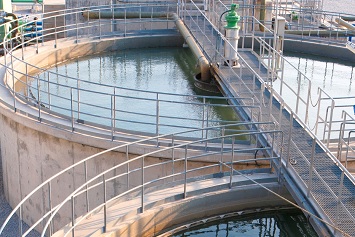The EPA announced $6.5 billion in new funding for water infrastructure projects on April 27, 2021. $5.5 billion is being made available in this round of funding under the Water Infrastructure Finance and Innovation Act (WIFIA) program, with another $1 billion in funding for the state infrastructure financing authority WIFIA (SWIFIA) program.
 WIFIA, created in 2014, is a federal loan and guarantee program that aims to accelerate investment in the nation’s water infrastructure by providing long-term, low-cost supplemental loans for regionally and nationally significant projects.
WIFIA, created in 2014, is a federal loan and guarantee program that aims to accelerate investment in the nation’s water infrastructure by providing long-term, low-cost supplemental loans for regionally and nationally significant projects.
The Scope of the Water Infrastructure Issue
To date, according to the American Society of Civil Engineers (ASCE), neither federal, state, nor local government spending has kept pace with necessary repairs to aging and often outdated water infrastructure systems.
The ASCE’s latest annual report gave the U.S. water infrastructure a C- grade.
According to the ASCE, there are 2.2 million miles of underground pipes in the U.S. water system, with water main breaks occurring every 2 minutes. Those breaks result in an estimated loss of 6 billion gallons in treated water per day—enough to fill more than 9,000 swimming pools.
“Our nation’s drinking water systems face staggering public investment needs over the next several decades,” said the ASCE. “ASCE’s 2020 economic study, ‘The Economic Benefits of Investing in Water Infrastructure: How a Failure to Act Would Affect the U.S. Economic Recovery’ found that the annual drinking water and wastewater investment gap will grow to $434 billion by 2029. Additionally, the cost to comply with the EPA’s 2019 Lead and Copper Rule is estimated at between $130 million and $286 million. Drinking water utilities also face increasing workforce challenges. Much of the current drinking water workforce is expected to retire in the coming decade, taking their institutional knowledge along with them. Between 2016 and 2026, an estimated 10.6% of water sector workers will retire or transfer each year, with some utilities expecting as much as half of their staff to retire in the next five to 10 years.”
Positive Signs
“However, there are signs of progress as federal financing programs expand and water utilities raise rates to reinvest in their networks,” according to the ASCE report. It is estimated that more than 12,000 miles of water pipes were planned to be replaced by drinking water utilities across the country in the year 2020 alone. In 2019, about a third of all utilities had a robust asset management program in place to help prioritize their capital and operations/maintenance investments, which is an increase from 20% in 2016. Finally, water utilities are improving their resilience by developing and updating risk assessments and emergency response plans, as well as deploying innovative water technologies like sensors and smart water quality monitoring.”
The 2021 notice of funding availability builds upon the existing active pipeline of WIFIA projects, which includes 76 projects in 25 states, according to the EPA.
“EPA’s $6.5 billion in water infrastructure funding will provide more than $13 billion in water infrastructure projects while creating more than 40,000 jobs,” said EPA Administrator Michael S. Regan. “Today’s announcement illustrates the multiple benefits of investing in water infrastructure—better public health and environmental protection, job creation, and economic development.”
“[The] EPA’s WIFIA loan program has become one of the most effective tools used to upgrade our nation’s infrastructure,” says the Agency. “To date, EPA’s 49 WIFIA loans are providing over $9.3 billion in credit assistance to help finance nearly $20 billion for water infrastructure while creating approximately 49,000 jobs and saving ratepayers over $4 billion.” According to the EPA, this latest funding will provide up to $5.5 billion to support $11 billion in water infrastructure projects and prioritizes five areas:
- Supporting economically stressed communities,
- Protecting water infrastructure against the impacts of climate change,
- Reducing exposure to lead and addressing emerging contaminants,
- Updating aging infrastructure, and
- Implementing new or innovative approaches, including cybersecurity and green infrastructure.
To further address the water infrastructure issue, the ASCE report suggests seven solutions:
- “Triple the amount of annual appropriations to the Drinking Water State Revolving Fund program and fully fund the WIFIA program and the U.S. Department of Agriculture Rural Development programs.
- Utilities should implement asset management programs, tools, and techniques to evaluate asset condition and risk, and to prioritize capital and [operations and maintenance (O&M)] decisions; states should provide funding, training, and technical assistance for asset management programs.
- Increase utilities’ resilience by integrating smart water technologies such as machine learning software and real time data sensors into drinking water infrastructure systems.
- Eliminate the state cap on private activity bonds for water infrastructure projects to bring an estimated $6 billion to $7 billion annually in new private financing.
- Increase federal and local support to find, train, and retain the next generation of the drinking water sector workforce to help offset the large number of expected retirements.
- Utilities need to conduct revenue forecasting models to determine the necessary rate revenues that reflect the true cost of water that is needed to provide safe, reliable drinking water and more resilient infrastructure.
- Develop and fund affordability programs to ensure that low-income and vulnerable communities do not bear a disproportionate burden of rate increases.
- Support voluntary partnerships for small community water systems in need.”
How Does WIFIA Work?
Borrowers eligible for WIFIA loans include:
- Local, state, tribal, and federal government entities
- Partnerships and joint ventures
- Corporations and trusts
- Clean Water and Drinking Water State Revolving Fund (SRF) programs
Development and implementation activities eligible for WIFIA funding include:
- Development phase activities, including planning, preliminary engineering, design, environmental review, revenue forecasting, and other preconstruction activities;
- Construction, reconstruction, rehabilitation, and replacement activities;
- Acquisition of real property or an interest in real property, environmental mitigation, construction contingencies, and acquisition of equipment; and
- Capitalized interest necessary to meet market requirements, reasonably required reserve funds, capital issuance expenses, and other carrying costs during construction.
The EPA requirements for WIFIA loans include:
- $20 million: minimum project size for large communities.
- $5 million: minimum project size for small communities (population of 25,000 or less).
- 49 percent: maximum portion of eligible project costs that WIFIA can fund.
- Total federal assistance may not exceed 80 percent of a project’s eligible costs.
- 35 years: maximum final maturity date from substantial completion.
- 5 years: maximum time that repayment may be deferred after substantial completion of the project.
Recent WIFIA Announcements
Washington, D.C.
On April 15, 2021, the EPA announced a $156 million WIFIA loan to the District of Columbia Water and Sewer Authority (DC Water) to fund new water mains and pumps. The project will also help prevent sewage contamination to the Potomac and Anacostia Rivers through updates to the stormwater management systems and collecting and treating wastewater.
“DC Water serves more than 700,000 residents, including many lower income communities and communities of color,” according to the EPA. “EPA’s WIFIA loan provides significant cost-savings—helping DC Water meet its water affordability goals. DC Water’s Comprehensive Infrastructure Repair, Rehabilitation and Replacement Program will cost $319 million and EPA’s WIFIA loan will finance nearly half of that figure—saving DC Water an estimated $30 million. These savings can be passed on to customers through continued service improvements from additional infrastructure investment or greater rate stability throughout the life of the loan. Additionally, with the savings realized from the low costs associated with the WIFIA loan, DC Water is able to continue its support for assistance programs to help customers in need.”
Louisville and Jefferson County, Kentucky
Also, on April 15, 2021, the EPA announced a $97 million WIFIA loan to the Louisville and Jefferson County Metropolitan Sewer District (MSD). The loan will help fund upgrades to improve the wastewater infrastructure. This MSD is Kentucky’s largest water quality treatment center.
“EPA’s WIFIA loan will finance nearly half of the $197.8 million project costs and will save MSD an estimated $15 million in financing costs,” according to the EPA. “In addition to the low cost, the WIFIA loan provides MSD flexibility in repayment terms as well as construction schedule, ensuring that the funding meets MSD’s needs throughout the life of the project. Project construction and operation are expected to create more than 600 local jobs and spur more than $850,000 in local community investment. Located in the west end community, improvements at the Morris Forman Water Quality Treatment Center will also improve local environmental conditions, including by reducing odors.”
Florida Keys, Florida
In its third WIFIA announcement on April 15, 2021, the EPA stated it had finalized a $49 million WIFIA loan to the Florida Keys Aqueduct Authority. The funds from the loan will be used to update the drinking water system so that it is more resilient in hurricanes, other extreme weather events, and climate-related changes.
“Drinking water for the Florida Keys is supplied by the mainland and pumped 130 miles from Florida City to Key West. In an emergency, the Keys can make their own freshwater at the Stock Island Reverse Osmosis Facility, which was essential in the aftermath of Hurricane Irma,” the EPA says. “However, the aging plant is failing and in need of significant and costly repairs. EPA’s WIFIA loan will help finance the Florida Keys Imperiled Water Supply Rehabilitation Project to replace a reverse osmosis plant that will provide a reliable alternative water supply during emergencies. Funding will also support additional upgrades to aging infrastructure throughout the system, including 12 miles of aging pipes and an underperforming water distribution pump station. These upgrades will help improve the system’s climate resiliency and mitigate the impacts of more frequent and severe hurricanes.”
“EPA’s WIFIA loan will finance nearly half of the total project cost of $100 million—saving the Florida Keys Aqueduct Authority an estimated $13 million. These savings can be passed on to customers through continued service improvements from additional infrastructure investment or greater rate stability throughout the life of the loan. Project construction and operation are expected to create more than 300 direct and indirect jobs,” according to the EPA.
These three projects bring the EPA’s total WIFIA loans to more than “$9.3 billion in credit assistance to help finance nearly $20 billion for water infrastructure while creating approximately 49,000 jobs and saving ratepayers over $4 billion.”
In the Pipeline
On April 13, 2021, the EPA announced it has invited two other water districts to access WIFIA funding.
“The Pacheco Reservoir Expansion Project for Santa Clara Valley Water District will receive a $693 million loan from WIFIA,” says the EPA. “The project will expand the Pacheco Reservoir to 140 thousand acre-feet by constructing a new dam, pump station, conveyance facilities, and related infrastructure. The project will boost operational capacity and reduce the frequency and severity of water shortages during droughts, protect drinking water supplies, and improve fish habitat.”
“WIFIA will provide a $441 million loan for the Alternative Water Source Program for the City of Joliet, which will construct infrastructure needed to access a new, sustainable drinking water source to replace the city’s reliance on the current sandstone aquifer that has declining water levels,” according to the EPA.
Joliet joins three other Chicago-area WIFIA projects: Chicago Department of Water Management, City of Evanston, and Metropolitan Water Reclamation District of Greater Chicago.
See the EPA’s WIFIA website for more information on this program and about applying for WIFIA loans.

